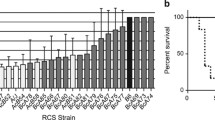Summary
The inheritance of resistance to Japanese encephalitis virus (JEV) was investigated using inbred strains of mice to study genetic resistance against JEV infection. C57BL/6 mice immunized intraperitoneally (i.p.) with an infective dose of JEV were resistant to intracerebral (i.c.) challenge with JEV, whereas most C3H/He mice treated in the same manner died. C57BL/6 mice developed this resistance 2 weeks earlier than C3H/He after intraperitoneal (i.p.) immunization. Passive transfer of spleen cells from immunized C57BL/6 protected the recipient mice from i.c. challenge, while transfer from immunized C3H/He was less effective. Since immunized athymic nude mice were not resistant to i.c. challenge with JEV, T lymphocytes were considered to be necessary for protection. When F1, F2 and backcross mice derived from C57BL/6 and C3H/He were challenged i.c. with JEV after i.p. immunizations, the number of resistant and susceptible mice were consistent with Mendelian ratios. Thus it can be concluded that resistance to JEV in mice was controlled by a single, dominant autosomal gene which was not linked toa (non agouti)-locus (chromosome 2).
Similar content being viewed by others
References
Bradley DJ, Taylor BA, Blackwell J, Evans EP, Freeman J (1979) Regulation ofLeishmania population within the host. 3. Mapping of the locus controlling susceptibility to visceral leishmaniasis in the mouse. Clin Exp Immunol 37: 7–14
Calich VLG, Burger E, Kashino SS, Fazioli RA, Singer-Vermes LM (1987) Resistance toParacoccidioides brasiliensis in mice is controlled by a single dominant autosomal gene. Infect Immun 55: 1919–1923
Darnell MB, Koprowski H, Lagerspetz K (1974) Genetically determined resistance to infection with group B arboviruses. 1. Distribution of the resistance gene among various mouse populations and characteristics of expression in vivo. J Infect Dis 129: 240–247
Fujisaki Y, Miura Y, Sugimori T, Morimoto T, Ino T (1976) Experimental studies on vertical infection of mice with Japanese encephalitis virus. 1. Effect of mouse strain on placental and fetal infection. Natl Inst Anim Health Q (Tokyo) 16: 97–106
Fujisaki Y, Sugimori T, Morimoto T, Miura Y (1975) Development of an attenuated strain for porcine use. Natl Inst Anim Health Q (Tokyo) 15: 15–23
Green MC (1981) Catalog of mutant genes and polymorphic loci. In: Green MC (ed) Genetic variants and strains of the laboratory mouse. G Fischer, Stuttgart, p 84
Gros P, Skamene E, Forget A (1983) Cellular mechanisms of genetically controlled host resistance toMycobacterium bovis (BCG). J Immunol 131: 1966–1972
Groschel D, Koprowski H (1965) Development of a virus-resistant inbred mouse strain for the study of innate resistance to arbo B viruses. Arch Ges Virusforsch 17: 379–391
Groves MG, Rosentreich DL, Taylor BA, Osterman JV (1980) Host defenses in experimental scrub typhus: mapping the gene controls natural resistance in mice. J Immunol 125: 1395–1399
Kitamura T (1975) Hematogenous cells in experimental Japanese encephalitis. Acta Neuropathol (Berl) 32: 341–346
Lindenmann J (1964) Inheritance of resistance to influenza virus in mice. Proc Soc Exp Biol Med 116: 506–509
Lynch CJ, Hughes TP (1936) The inheritance of susceptibility to yellow fever encephalitis in mice. Genetics 21: 104–112
Mathur A, Kamlesh LA, Chaturvedi UC (1983) Host defense mechanisms against Japanese encephalitis virus infection in mice. J Gen Virol 64: 805–811
Miura K, Goto N, Suzuki H, Fujisaki Y (1988) Strain difference of mouse in susceptibility to Japanese encephalitis virus infection. Exp Anim (Tokyo) 37: 365–373
Ogata T (1971) Method for testing potency in animals and their significance. A. General introduction: the potency testing of Japanese encephalitis vaccine. In: Hammon WM, Kitaoka M, Downs WG (eds) Immunization for Japanese encephalitis. Igakushoin, Tokyo, pp 65–71
Plant J, Glynn AA (1979) LocatingSalmonella resistance gene on mouse chromosome 1. Clin Exp Immunol 37: 1–6
Reed L, Muench H (1938) A simple method of estimating fifty per cent endpoints. Am J Hyg 27: 493–497
Sabin A (1952) Nature of inherited resistance to viruses affecting the nervous system. Proc Natl Acad Sci USA 38: 540–546
Webster LT (1937) Inheritance of resistance of mice to enteric bacterial and neurotropic virus infections. J Exp Med 65: 261–286
Yasui K (1979) Role of the cell-mediated immunity on Japanese encephalitis virus infection. In: Onodera K (ed) Advances in virology. Institute for Virus Research, Kyoto University, Kyoto, pp 91–106 (in Japanese)
Author information
Authors and Affiliations
Rights and permissions
About this article
Cite this article
Miura, K., Onodera, T., Nishida, A. et al. A single gene controls resistance to Japanese encephalitis virus in mice. Archives of Virology 112, 261–270 (1990). https://doi.org/10.1007/BF01323170
Received:
Accepted:
Issue Date:
DOI: https://doi.org/10.1007/BF01323170




